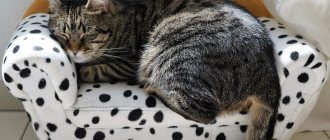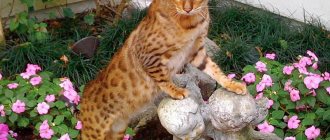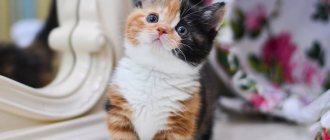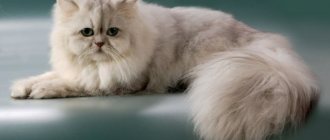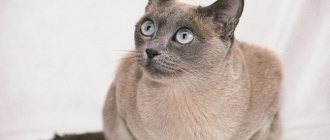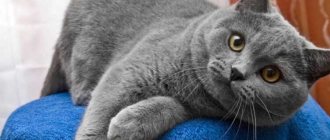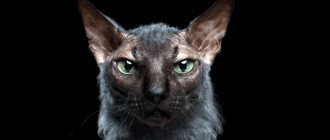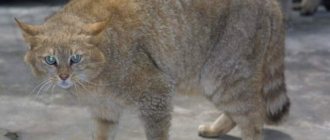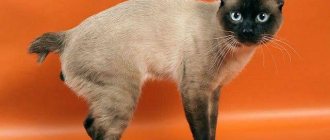Somali cats are beautiful animals with a unique ticked coloration and a luxurious fox-like tail. Their sophisticated appearance and piercing gaze of expressive eyes, combined with a playful disposition, make them desirable pets for novice felinologists. And in order not to make a mistake in choosing a breed, it is better to figure out in advance what else is hidden behind the mask of an exquisite aristocrat.
Brief history of the breed
The homeland of Somali cats is the United States, and they owe their appearance to American breeders. In the 40s of the last century, some breeders involved in breeding Abyssinians began to have kittens with long hair. Since they did not meet the generally accepted standard, they were considered a “manufacturing defect” and were distributed free of charge to friends.
This could have continued indefinitely if, in the late 1960s, long-haired Abyssinians had not attracted the interest of the owner of an American kennel, Evelyn Matthew. The woman named the unusual cats Somali and became the founder of the first society of lovers of this breed.
In parallel with her, the Canadian breeder Mary Mayling was promoting non-standard Abyssinians. She demonstrated long-haired beauties at exhibitions, helping to popularize them.
As a result, through joint efforts, the breeders were able to resist the resistance of Abyssinian nurseries that were actively fighting with competitors. Their actions led to Somalia being officially registered in the United States in 1978. And in 1982, the breed received recognition from the International Cat Federation.
Flaws in appearance
Often kittens do not meet all of these standards. If the breeder's goal is a companion cat for the home and family, these deviations are not a hindrance.
If the owner plans to take first places at exhibitions, the animal should be seriously studied.
Cats that have:
- There is no ticking.
- There are no “glasses” around the eyes.
- Irregular shape of the head and muzzle.
- Inelegant, rough body.
- Short tail.
- Gray undercoat.
- White markings on body.
- Cryptorchima (testicles not descended).
- Polydactyly (extra fingers).
At first glance, a cat may meet all the required characteristics, but with age, deviations can unexpectedly appear. These traits rarely affect the health of the cat, but its reproduction and participation in competitions are doomed.
Interesting Facts
Over the years of the breed’s existence, many interesting things have been associated with it:
- For its fluffy tail and fiery fur, the Somali cat received the nickname “domestic fox.”
- Representatives of the breed love to play with water. Somalia likes to catch splashes with its paws. In addition, they can independently open the taps and look at the dripping water for a long time.
- The name of the breed was not chosen by chance. Due to the fact that the ancestors of these animals were Abyssinian cats, it was decided to name them Somali in honor of the country that neighbors Abyssinia on the map (now Ethiopia).
What owners say about the Somali cat
If you have a Somali cat in your home, you probably read reviews about it on the Internet in advance. But just when you are planning to get a Somali, you can still look for available information. We would like to present to your attention a review left on our website by the real owner.
Egor, 25 years old.
It is not for nothing that Somalis are described as very active animals. These are real fidgets. At least my cat Franklin confirms this: in the 3 years of living in my apartment, I have never noticed him sitting idle, unless he was sleeping, of course.
Looking at his cute face, you would never think that he is capable of scratching, biting and generally rebelling in some way. But this is a misleading impression.
This Somali cat, like a pirate from his homeland, is constantly looking for some adventure. And the more dangerous they are, the happier his cunning face is. He constantly, literally “meows” my attention - if he’s in the mood to play, he won’t leave until he gets tired of it, and it doesn’t matter whether I want to communicate with him or not.
He always needs to climb somewhere, observe something, study everything that catches his eye.
Franklin will not miss an opportunity to play pranks and mischief, for example, he can steal some small necessary thing right from under my nose, as soon as I gape, dump it on the floor, and even hide it somewhere under the sofa. Sometimes I really want to rip him by the scruff of the neck... But it’s a pity. And without these tricks of his it would have been even boring.
I advise everyone who does not need a bland, monotonous life alone with a constantly snoring cat to buy a Somali - life will be fun, with a sparkle))
Breed description, standards, appearance
Somali cats are fluffy animals with a stretched, flexible body and a long tail. Outwardly, they are very similar to representatives of the Abyssinian breed, but they have their own standard and several fundamental differences.
Dimensions and weight
Representatives of the Somali cat breed are not heavyweights. But due to the fact that they have developed sexual dimorphism, females look lighter and smaller than males. The average weight of a Somali cat is 2.5-4 kg. The weight of an adult cat can reach 4-5 kg.
Anatomical characteristics
A typical Somali cat should fit the following description:
- The head is wedge-shaped, with rounded lines, a smoothly contoured profile and a strong chin.
- The eyes are large, wide-set, almond-shaped. The iris color can vary from amber to green. Silver Somalis prefer green eyes.
- The ears are large, set far apart, with a wide base and slightly rounded tips.
- The body is flexible, long, with developed muscles, a slender neck and a slightly protruding chest.
- The limbs are slender, tall, with small oval paws.
- The tail is long, thick at the base, gradually tapering to the tip. Fluffy fur grows thickly on it.
Color and coat type
Somali cats are covered with a smooth, thick coat, under which lies a thin but dense down. There is less hair on the back and shoulder blades of this breed than on the belly. The Somali has a luxurious “collar” on its neck, and “pants” on its hind legs.
On a note. According to the standard, the Somali cat can have whiskers. And in the interdigital space the presence of tufts of wool is allowed.
The main distinguishing feature of the Somali cat is the presence of ticking. Each hair of an animal must have dark transverse stripes, and the more of them, the more valuable the individual is considered. According to the standard, Somali cats can have the following colors:
- Wild – brown-red or slightly reddish coat with black ticking. On the back of the Somali there is a dark line called the "dorsal strap".
- Sorrel is a coppery-red coat with red-brown ticking. The bases of the Somali hairs are apricot-colored. The tips of the ears and tail are brown, the paw pads and nose are pink.
- Fawn - matte beige coat with dark cream ticking. The bases of the hairs are colored light cream.
- Blue – gray-blue wool with steel ticking. The bases of the Somali cat's hairs are cream or light beige. Paw pads are gray with a blue tint.
On a note. Somali cats are allowed to have “silvered” colors. They are a combination of light base and ticking.
Possible breed defects
Flaws in appearance, in the presence of which a cat of the Somali breed will not receive the highest expert rating:
- short tail;
- rough build;
- heavy head;
- no ticking;
- cryptorchidism;
- gray undercoat;
- polydactyly;
- blurry shade of fur.
Colors of cats and kittens of the Somali breed with photographs
The most common coat color for this breed is a wild, red with black tips, a light apricot tint on the inside of the body, and a dark tint on the back.
Also popular is a copper-red shade (sorel) with dark red shading.
An amazing coat of smoky blue and silver with a white undercoat and a variety of shades!
Character and temperament
Somali cats are endowed with a friendly and playful disposition. Aristocratic and sociable representatives of the breed remain cheerful until old age and extremely rarely show aggression. Curious and active, Somali cats are not the type to snooze quietly on the couch. They explore every corner of the apartment more than once and find something to do with themselves.
Friendly and sociable, Somalis get along well with children and will never let their claws out. The good nature of cats of this breed extends not only to people, but also to other animals. The non-conflict nature of the Somalia helps them easily find a common language with their brothers, non-aggressive dogs, fish, birds and ornamental rodents.
Mating
Usually, the first heat of a Somali cat begins at 8 months. But this is still too early an age for motherhood; it is better to wait until a year.
This breed suffers from infertility, and even healthy cats often cannot become pregnant for a long time. In this regard, the price of the Somali cat remains at a high level.
Kittens should be kept near their mother until they are three months old. If you take the kids earlier, they will fall into a stressful state, which will affect their future upbringing and even health.
If your Somali cat is not bred, estrus will occur more often. If you completely neglect a cat regarding issues of reproduction, the functions of the reproductive system will eventually be disrupted and cysts and polyps will begin to form.
After the mating of the Somali cat has been successfully completed, you can begin preparing for the birth of offspring.
The Somali, like other cats, gestates for 65 days.
Newborn Somali cubs inherit a bright color, the expressiveness of which only intensifies as the animal grows older. Little kittens are very active and inquisitive, and in search of new and interesting things they can go where they shouldn’t, so they require some supervision.
How to choose the right kitten
Somali cats are distributed throughout the globe. Therefore, there are usually no problems with buying such a pet. To protect yourself from possible deception, it is better to purchase a Somali kitten from a certified nursery or from a trusted breeder. At the time of purchase, he must have documents about his origin and vaccinations.
The Somali kitten chosen must meet the breed standard and show no signs of cowardice. It is important that he has clean eyes and ears, a soft belly, fluffy fur and smooth skin without scratching or rashes. A healthy Somali kitten should not have bad breath or dirt under its tail.
Kitten care
Responsible breeders do not wean Somali kittens from their mother before they are 12 weeks old. Therefore, kids move to new homes completely independent. This means that the owners can only give them a little time to get used to the changed conditions and ensure safety.
To prevent the curious Somali kitten from being injured while exploring his property, decorative plants, chemicals, small objects and wires are hidden from him. Also, for security reasons, his access to large household appliances and open windows is blocked.
Choosing a kitten and the price of Somalia
There are more and more breeders breeding Somali cats, as well as representatives of the breed themselves, every year. Therefore, buying a purebred kitten is not so difficult, especially if high demands are not placed on it.
When choosing a Somali kitten, it is very important to evaluate its parents, their external characteristics and character. They also pay attention to the living conditions of the cats, their diet, appetite and appearance. By the time of moving to a new home, the baby must be vaccinated, accustomed to the tray, and ideally, to the scratching post.
The cost of Somali kittens varies widely. Pet-class babies usually cost 15-25 thousand rubles. If kittens were born from purebred parents, but do not have documents, their cost is immediately reduced to 5,000-10,000 rubles. Individual representatives of the breed of elite lines or rare colors can cost much more - from 40,000 rubles. and higher.
Any color of the Somali cat evokes enthusiastic oohs and aahs. But this is not a reason to lose vigilance when purchasing.
If you decide to buy a Somali cat, make sure that its color does not have a sandy, gray tint, or black root zones. Also make sure that there are no residual patterns on the animal’s body:
- stains on the body;
- stripes on paws.
All these signs indicate a deficiency in the breed, but the indicator that definitely disqualifies a kitten is the presence of white spots everywhere except the throat, chin and nostril area. In addition, from the point of view of the breed, the presence of a hooked tail tip is considered unacceptable.
In appearance, a Somali cat kitten should be active, playful and strong. It is better not to adopt a kitten that looks aggressive or scared; take a friendly animal.
Care and maintenance
Somali cats easily adapt to different conditions and do not require special care. The owner can only provide basic hygiene, proper feeding and timely veterinary care.
Hygiene procedures
In order for a cat of the Somali breed to look neat, it is provided with proper care:
- The animal's ears are cleaned weekly with a cotton swab soaked in a special lotion. If pus or other unusual discharge is detected, the cat is taken to the veterinarian.
- Somali eyes are wiped daily with a clean cloth moistened with boiled water or chamomile infusion.
- The cat's claws are shortened with a nail clipper as they grow. In order not to cause pain to your pet, you must act very carefully so as not to touch living tissue.
- Somali teeth are brushed 3-4 times a month with a special brush with a small amount of non-foaming paste. This procedure will help remove plaque and prevent stone formation.
Grooming
The Somali cat's coat is not prone to tangles. To ensure that the coat always looks well-groomed, it is regularly combed with a special comb with rare teeth.
Important! It is not recommended to brush Somali cats with plastic combs and brushes with artificial bristles, as they have a detrimental effect on the condition of the protective layer of the coat.
Representatives of the breed are bathed no more than 3-4 times a year. To do this, use yolk shampoos or products for long-haired breeds and water, the temperature of which does not exceed 40 degrees. A washed Somali cat is dried with a towel and dried with a hairdryer.
Tray
For cat litter, it is advisable to use a convenient, easy-to-clean tray with high sides. The litter is usually selected taking into account the preferences of a particular animal.
Who to choose: a male cat or a Somali cat?
Little Somali kittens are very touching and funny. When choosing a pet for your home, you need to decide on the gender of the animal - boy or girl? In order not to make a mistake in this decision, you need to study the individual characteristics of cats and kittens.
Cats are more affectionate and attached to their owner. They get used to their new home faster and behave more carefully and cautiously. General characteristics also include observation and curiosity of the fair sex.
The owner of a cat of the Somali breed must understand that his pet may soon bear offspring.
If you are not going to engage in breeding of Somalis and want to eliminate problems with the appearance of kittens, it is better to agree in advance with a veterinarian and carry out the age-appropriate sterilization procedure.
Experts strongly do not recommend keeping a cat at home during the period of heat, trying to exclude sexual contact with street representatives. Abstinence from the natural process can negatively affect the psychological and physical condition of your pet.
In addition, a cat that wants to go on a spree will simply not give rest to all household members; it will hysterically look for a way out of the room and demand access to the street.
Males are less problematic in terms of offspring. You can let him go outside without fear, without worrying about the offspring. But you should understand that a wandering cat may not return home for weeks, and in some cases, after such sprees, they disappear forever.
In order not to lose your pet, you can perform castration, which is important if the cat has free access to the street.
There is also the option of finding a purebred cat for mating, which will save you from worries and other possible problems, and at the same time calm down the unbridled sexual fervor of your furry friend.
Feeding the cat
Somalis require a balanced diet and most breeders recommend dry feeding them. But cats will not refuse natural food. Therefore, when choosing food, each owner takes into account his own capabilities.
Complete diet
With the industrial type of nutrition, Somalis buy high-quality premium or super-premium food, which does not contain soy, preservatives or dyes. Cats of this breed digest well the following brands:
- Brit Care;
- Pronature;
- Royal Canin;
- Grandorf.
With a natural type of nutrition, Somalis select a diet that consists of 70-80% meat. The cat menu is also supplemented with cereals, non-starchy vegetables, offal, fermented milk, eggs and ocean fish.
It is strictly forbidden to treat Somalis with bones, sweets, pastries, sausages and pork. It is also undesirable to give cats of this breed river fish, onions, whole milk, smoked meats, pickles and any leftovers from the master's table.
Important! In order not to provoke gastrointestinal problems in your cat, it is not advisable to mix natural and industrial food.
Feeding frequency
Somali kittens eat little, but often. Therefore, when drawing up a feeding schedule, the age of the animal must be taken into account:
- up to 3 months – 5-6 times a day;
- 3-5 months – 4 times a day;
- 5-12 months – 3 times a day.
From the age of one year, the Somali cat is fed twice a day.
Vitamins and minerals
In the body of Somali cats that eat natural foods, a deficiency of microelements may occur. To compensate for the lack of nutrients, animals are given vitamin and mineral supplements twice a year. The choice of feeding should be made by a veterinarian, taking into account the characteristics of a particular cat.
On a note. If a Somali eats high-quality dry food, she does not need additional vitamins.
Catering
A balanced and healthy diet is the key to your pet’s well-being and beautiful appearance. Somali cats get used equally well to both industrial food and natural food, but choose one: mixing one with the other, the animal will develop intestinal upset.
Recommended food
Ready-made food saves a lot of time, not forcing you to regularly stand at the stove. But you need to know how to choose it! Don't believe loud advertisements and bright wrappers on TV screens: read the labels on the packages. Good food does not use meat waste, dyes, artificial preservatives, flavor enhancers, etc. Economy and premium food: PreVital, Sheba, Whiskas.
But the food from the holistic and super-premium groups is much better in quality. They cost, of course, significantly more, but take a look at the composition! A good vitamin and mineral supplement, dried vegetables, berries and fruits, natural preservatives (tocopherols), rice, lentils and potatoes as sources of carbohydrates, dehydrated and fresh fish fillets and meat - all this saturates the pet and is beneficial for the pet.
Holistic foods recommended by experienced breeders: Applaws, Go Natural, Grandorf. Super premium ones include: Brooksfield, Duke's Farm, Fitmin For Life.
Below are the recommended holistic and super-premium foods. Links with the names of the food are clickable, on them you can, within our website, read the descriptions of the food and read reviews from owners of Somali cats.
| Holistic | Super premium | Super premium |
| Acana | Dr Clauder's | Brit Care |
Natural products
Not everything is simple with natural food either. Your food - soups, purees, cutlets, fried wings - is absolutely not suitable for a cat. Therefore, you will have to cook for her separately.
The correct menu consists of the following products:
- Porridges boiled in water: rice, buckwheat, millet, oatmeal, lentil. You need to add finely chopped vegetables to the porridge: pumpkin, beets, zucchini, carrots. Pour in half a teaspoon of oil (olive, sunflower or flaxseed), add some herbs (dill, parsley or green salad and crumble the boiled chicken yolk). Your pet will eat this porridge with pleasure.
- Meat is the main part of the diet. It should be given every day, defrosted and doused with boiling water (to destroy parasite larvae). Veal, rabbit, turkey, beef, lamb - whatever you have enough money for. Pamper your cat with offal a couple of times a week. These are chicken necks (ground into minced meat), chicken gizzards and hearts, and cartilage. Kittens are usually started feeding baby meat food.
- You can give fish, but rarely: no more than once a week. And only sea fish: trout, hake, flounder, salmon. Boiled squid and finely chopped shrimp can also be included in the diet.
- Among dairy products, cats are very fond of low-fat cottage cheese, yogurt, sour cream, natural yoghurts, and hard cheeses.
- Treats for cats: not cookies or candies, but cucumbers, melons, apples, pears. Green grass (sprouted wheat and oats) is also not a whim, but a necessity. With its help, the cat gets rid of hairballs that have entered the stomach.
You cannot give:
- Fatty or rotten meat, lard, pieces of fat, tripe, bones (even boiled);
- Sausages, sausages, smoked meats, canned food for people;
- River fish, fish with small bones;
- Pea and chickpea porridge, white cabbage, avocado, grapes, bananas, eggplants, potatoes, tomatoes, onions, garlic, citrus fruits;
- Human drinks: juices, mineral and sparkling water, coffee, tea, cocoa;
- Spices and seasonings, salt, sugar;
- Baked goods, flour, spicy, flour, sweet, salty, dried, pickled.
Be careful with whole cow's milk. If the cat has been accustomed to it since childhood and has no problems with the stomach or “stool”, then there is nothing to worry about. Otherwise, avoid milk.
An adult cat is fed no more than 2 times a day: morning and evening. An exception is made for pregnant cats, as well as seriously ill animals. Kittens up to six months are fed 3-6 times; the younger the baby, the more often they eat.
Somalis are water-drinkers, so fresh and clean water should always be poured into their bowl. If her cat sees even a speck of dust on the surface, she will not drink, but will crawl to the tap or even into the toilet. Water can be bought in a store, purified through a filter, or left in an open pan for 10-12 hours.
Education and physical activity
Somalis are smart animals with good memory and a high level of intelligence. Representatives of the breed quickly become accustomed to the tray and easily learn the rules of behavior in the house. If desired, Somali cats can be taught basic commands.
Representatives of the breed are endowed with an energetic temperament and remain active even in old age. Therefore, owners need to make sure that the Somali has enough toys and a tall scratching post tree.
On a note. The Somali cat loves to be outside, especially if it is taught to walk on a harness from childhood.
How to name a pet
Before choosing a name for a Somali cat, it is important to take into account several aspects - its appearance, the pet’s character traits. The nickname should be as suitable as possible for the animal, but in no case should it confuse strangers who hear the cat’s name for the first time. The following names are often chosen for Somali kittens:
Popular nicknames for cats.
Vaccinations and antiparasitic treatment
To prevent infectious and viral diseases, Somalis undergo routine vaccination. At the age of 7-8 weeks, a kitten of this breed is vaccinated against panleukopenia, rhinotracheitis and calcivirosis. After 28 days, he is vaccinated against the same diseases and against rabies. Subsequently, Somalis are vaccinated annually.
To prevent a cat of this breed from becoming infected with diseases carried by fleas and worms, it is regularly treated for external and internal parasites. Somali anthelmintic drugs are given once every six months with mandatory repetition after 10-14 days. The dosage of the medicine is calculated taking into account the weight of the cat.
Somalis are protected from fleas with drops, shampoos and anti-parasitic collars.
Diseases
Somali cats have strong immunity and low susceptibility to infections; they have few specific diseases.
- Firstly, Somalis are susceptible to such troubles as gingivitis (inflammation of the gums). Therefore, the owner needs to take special care of the cat’s teeth: brush them and show the pet to the veterinarian from time to time.
- Secondly, it recently became clear that autoimmune hemolytic anemia, which was considered a canine disease, is also susceptible to Somali cats. The diagnosis is made after donating blood according to the PCV classification, and treatment consists of prescribing steroid drugs.
The rest is the same as with other cats. Be sure to rid your cat of worms (even if she is sitting at home, and the environment around her is, in your opinion, sterile), get the necessary vaccinations, and work with your doctor to select a good vitamin and mineral complex. Then your pet will live long and feel good.
Pros and cons of the breed
Like any other breed of cat, the Somali has not only advantages, but also disadvantages.
| pros | Minuses |
| High level of intelligence | Need for space for games |
| Lack of excessive shedding | Tendency to serious illnesses |
| Low maintenance |
Somali cats are attractive animals with aristocratic habits and natural grace. Their mischievous nature and love for children make them real contenders for the right to be called ideal companions for young families in which kids who dream of a furry pet are growing up.
Vices
Good health does not insure an animal against hereditary diseases. Somalia is distinguished by the presence of several genetic diseases.
Progressive retinal atrophy
This pathology manifests itself in an animal at the age of six months and within a few years leads to complete loss of vision. The disease cannot be treated.
The only possible prevention is a thorough study of the pedigree when choosing a cat or preparing for mating. Detection is possible using electroretinography.
Hemolytic anemia
The cause of the disease is a lack of oxygen in the blood due to the destruction of red blood cells, which occurs due to a lack of a certain type of enzyme in the body. The cat will constantly be sick, pregnancy in this case becomes impossible. This makes itself felt throughout the pet’s life and requires constant treatment.
Due to the bottleneck effect, when few individuals remained after the war, all modern Abyssinian and Somali cats are close relatives, which makes them especially vulnerable to genetic pathologies.
Timely study of the pedigree will help the breeder choose an animal with minimal risk.
Health
Characteristic diseases
The health of representatives of this breed is excellent; teeth and gums occasionally bother them. Therefore, regular preventive measures are mandatory.
Somali cats are friendly to animals of other species, sometimes even trying to make friends with them. At the same time, dogs, parrots, rabbits and unfamiliar cats are shocked by this attitude and do not always accept the offer to play
Vaccinations
At 9-12 weeks you can give your kitten the first vaccination. It will protect him from several diseases at once:
- chlamydia
- plague
- calicivirus
- rhinotracheitis
You can read more about distemper in cats here:
Vaccination requires revaccination (repeat) after about a month. The rabies vaccine, at the owner's request, is administered with the first or second vaccination.
Further revaccination - at 1 year, and then annually.
A cat needs to be taught to be neat from childhood, then there will be no problems in adulthood


